
endangered
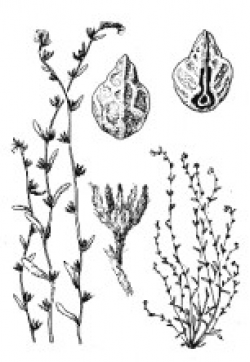
Illustration from Abrams (1951).
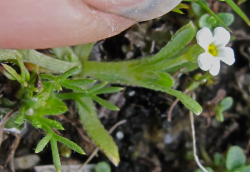
Photo taken at Wilder Ranch State Park © 2013 Dylan Neubauer.
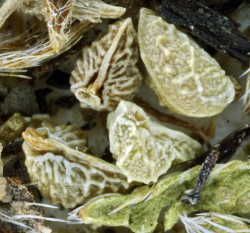
Photo of nutlets on herbarium specimen from Swanton area © Steve Matson.
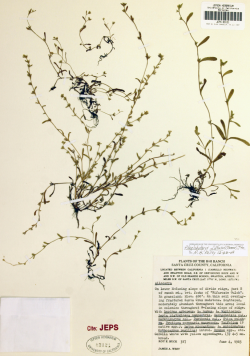
Photo of herbarium specimen from Swanton area © Steve Matson.
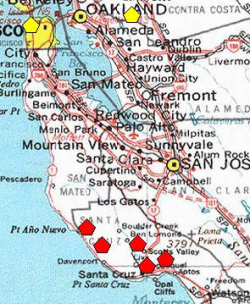
A red polygon indicates an extant occurrence; yellow indicates the occurrence has been extirpated.



This fact sheet was prepared by Grey F. Hayes and Dean W. Taylor under award NA04N0S4200074 from the National Oceanic and Atmospheric Administration (NOAA), U.S. Department of Commerce (DOC). The statements, findings, conclusions, and recommendations are those of the authors and do not necessarily reflect the views of the NOAA or the DOC.
© Copyright 2006, Elkhorn Slough Coastal Training Program
Last updated: Mar 7, 2015 10:27
Common Names - San Francisco popcorn-flower
Family - Boraginaceae (Borage Family)
State Status - state endangered
(September 1979)
Federal Status - none
Habitat
Sparsely vegetated, mesic sites in coastal prairie or serpentine bunchgrass grasslands; 30–150 m.
Key Characteristics
Annual herb, strigose, stems prostrate to ± ascending; lower cauline leaves 5–10 cm, alternate, linear; bracts similar to the leaves, many, spreading, throughout inflorescence, flowers well spaced, pedicels ca. 1 mm long; calyx 2.5–5 mm, lobes ± appressed-hairy; corolla limb (2)3–5 mm diameter, appendages yellow turning white; nutlet 1–1.5 mm long, ovate, ± smooth to ± tubercled; lower part of adaxial ridge in deep trough, scar near base, elliptic to ovate, deep-concave, sunken. Resembling P. trachycarpus except for nutlets, which are similar to those of P. reticulatus. Santa Cruz plants have differing nutlet surface characters (Kelley 2013).
Flowering Period
March to June
Reference Population
Pogonip (Santa Cruz County).
Global Distribution
Endemic to central California in Alameda, Santa Cruz, San Francisco (presumed extirpated), and San Mateo counties (CNPS 2014).
Conservation
Twelve occurrences are known for this species. The type locality at the Presidio in San Francisco is presumed extirpated. Populations in Santa Cruz County have been impacted by loss of habitat by development and non-native species such as Trifolium subterraneum and Hypochaeris radicata. As of 2015, plants had not been observed for the previous two years at the Graham Hill Rd. site, where the plant is associated with the listed Santa Cruz tarplant (Holocarpha macradenia) and Gairdner's yampah (Perideridia gairdneri ssp. g.) (Haley, pers. comm.). Colonies at Wilder Ranch State Park also appear to have diminished over recent years (Hyland, pers. comm.). A small colony at Marshall Field on the upper UCSC campus was still extant as of 2015, though plants did not number more than 50. This area is being heavily impacted by mountain bikes. As of 2015, two of the several remaining mini-colonies in the Scott Creek watershed have not appeared over the past two seasons probably due to low rainfall amounts. These two colonies have never numbered more than 20-30 plants in a good season. The other colony is still extant and has not been adversely impacted by either grazing or competition from native and non-native grasses (West, pers. comm.).
Reference
Abrams, L. R. 1951. Illustrated Flora of the Pacific States, Vol. 3. Stanford University Press, Palo Alto, CA.
California Natural Diversity Database (CNDDB). 2015. California Department of Fish and Wildlife RareFind 5. http://www.dfg.ca.gov/biogeodata/cnddb/mapsanddata.asp [accessed 25 February 2015].
CNPS, Rare Plant Program. 2014. Plagiobothrys diffusus, in Inventory of Rare and Endangered Plants (online edition, v8-02). California Native Plant Society, Sacramento, CA. http://www.rareplants.cnps.org/detail/1383.html [accessed 25 February 2015].
Haley, V. Personal communication [26 February 2015].
Hyland, T. Personal communication [26 February 2015].
Kelley, R. B. 2013. Plagiobothrys difusus, in Jepson Flora Project (eds.). Jepson eFlora, http://ucjeps.berkeley.edu/cgi-bin/get_IJM.pl?tid=38493 [accessed 25 February 2015].
West, J. A. Personal communication [25 February 2015].
